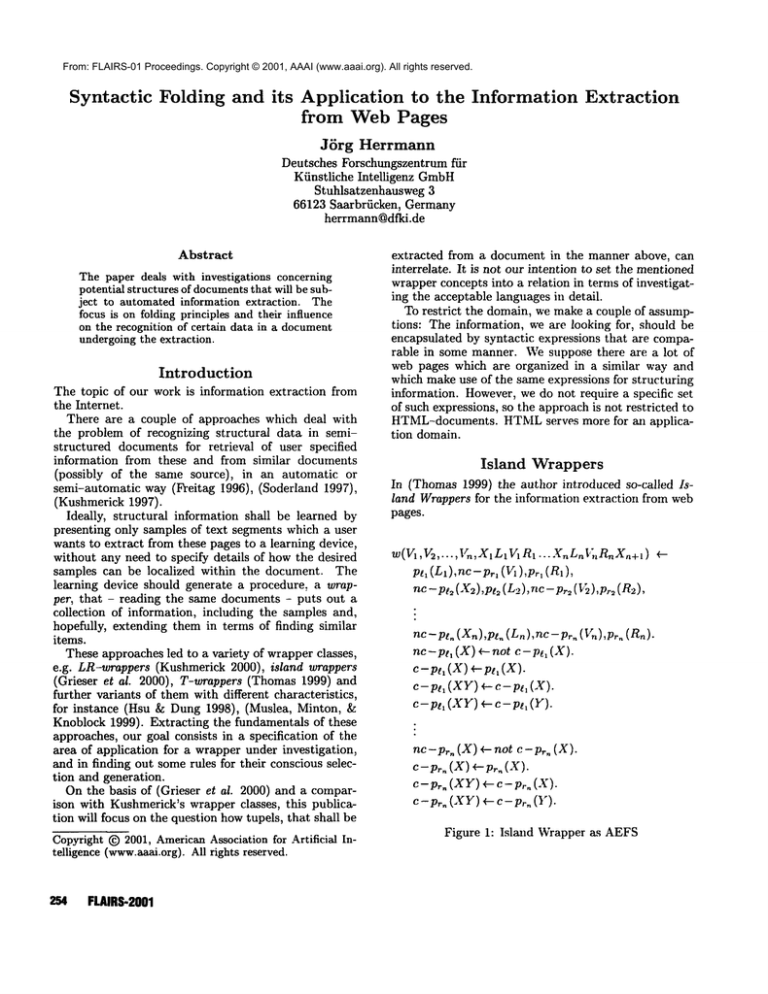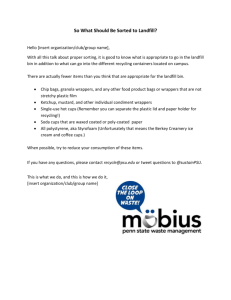
From: FLAIRS-01 Proceedings. Copyright © 2001, AAAI (www.aaai.org). All rights reserved.
Syntactic
Folding and its
Application to the Information Extraction
from Web Pages
J/Srg
Herrmann
Deutsches Forschungszentrum f/ir
K/instliche Intelligenz GmbH
Stuhlsatzenhausweg 3
66123 Saarbr/icken, Germany
herrmann@dfki.de
Abstract
The paper deals with investigations concerning
potential structures of documentsthat will be subject to automated information extraction. The
focus is on folding principles and their influence
on the recognition of certain data in a document
undergoingthe extraction.
Introduction
The topic of our work is information extraction from
the Internet.
There are a couple of approaches which deal with
the problem of recognizing structural data in semistructured documents for retrieval of user specified
information from these and from similar documents
(possibly of the same source), in an automatic
semi-antomatic way (Freitag 1996), (Soderland 1997),
(Kushmerick 1997).
Ideally, structural information shall be learned by
presenting only samples of text segments which a user
wants to extract from these pages to a learning device,
without any need to specify details of how the desired
samples can be localized within the document. The
learning device should generate a procedure, a wrapper, that - reading the same documents - puts out a
collection of information, including the samples and,
hopefully, extending them in terms of finding similar
items.
These approaches led to a variety of wrapper classes,
e.g. LR-wrappers (Kushmerick 2000), island wrappers
(Grieser et al. 2000), T-wrappers (Thomas 1999) and
further variants of them with different characteristics,
for instance (Hsu & Dung 1998), (Muslea, Minton,
Knoblock 1999). Extracting the fundamentals of these
approaches, our goal consists in a specification of the
area of application for a wrapper under investigation,
and in finding out some rules for their conscious selection and generation.
On the basis of (Grieser et al. 2000) and a comparison with Kushmerick’s wrapper classes, this publication will focus on the question howtupels, that shall be
Copyright(~) 2001, AmericanAssociation for Artificial Intelligence (www.aaai.org).All rights reserved.
2S4
FLAIRS-2001
extracted from a document in the manner above, can
interrelate. It is not our intention to set tile mentioned
wrapper concepts into a relation in terms of investigating the acceptable languages in detail.
To restrict the domain, we make a couple of assumptions: The information, we are looking for, should be
encapsulated by syntactic expressions ttlat are comparable in some manner. Wesuppose there are a lot of
web pages which are organized in a similar way and
which make use of the same expressions for structuring
information. However, we do not require a specific set
of such expressions, so the approach is not restricted to
HTML-documents. HTMLserves more for azl application domain.
Island
Wrappers
In (Thomas 1999) the author introduced so-called Island Wrappers for the information extraction from web
pages.
w(V1, V2,..., I~,XI LI V1R1...X,~L, I’;~R,X,+I
PE, (Ll),nc-pr, ($q ),Pr, (RI),
nc -Pt2 (X2),Pt2 (L2),nc-pr2 (t’~),pr~ (R2),
nc-ptn (Xn),pt. (n~),nc-p~= (t~),p,.
nc-pt~ (X) +-not c-pe, (X).
c-pc, (X) +- Pt, (X).
c-pc, ( XY) +- e- pe~ (X).
c- p~, (XY) +- c- p~, (Y).
nc - p~. ( X ) +-notc - pr. ( X
c-pr~(Z)+-p~(X).
c-p,. (XY) +- c-p~ (X).
c-p~. (XY) +- c- p~. (Y).
Figure 1: Island Wrapper as AEFS
One might distinguish certain ideas underlying that
concept:
¯ There is a document containing the information of
interest in the form of tupels t = (tt, ..., tin), ti E +
Z
for any fixed m,
¯ the quantity of such tupels per documentD is greater
than 1: I]TD][ > 1 for TD= {tit in D}, and
¯ the tupel embedding in D follows a predefined pattern, a so-called wrapper.
In (Grieser et al. 2000) island wrappers have been
represented by Advanced Elementary Formal Systems
(AEFS), an advancement of Elementary Formal Systems (EFS) known from Smullyan (Smullyan 1961).
Figure 1, taken from (Grieser et al. 2000), shows such
an AEFS.
Within this AEFS, V1,...Vn denote extraction variables for storage of the information a user wants to extract from a document. The Li and Ri are replacement
symbols for delimiters and the Xi play the role of wild
cards. Their combination in the last argument of the
predicate w specifies a pattern resp. the order in which
the substitutions of the variables are expected to occur
in the document. The subsequent constraints reduce
the search space for these substitutions. For instance,
V1 must not contain a segment of the document that
can be matched by RI.
Alternatively, the language Tx(D) accepted from a
document D by an island wrapper X might be represented as follows1:
Tx(D)
{t lt~T}
3/eT:
o(f,t)
with
3f’l,reT:
--D
o[f’.(l®t®r)]
Lleft = {l,},
vi:_i
,
Vi<m: f~+t¢’
(1)
= 73
. = {r,}
Lright
(2)
(3)
E* r-l~/t
where T denotes the set of tupels with nonempty components, and T denotes a superset that allows empty
components too.
Condition (1) states that the order of tupel components ti is fixed. Furthermore, those components are
subwords of the underlying document D, what in turn
implies there is no need to investigate tupel semantics.
One has to look for syntactic structures only.
The li are called left anchors, the ri right anchors(cf.
(Grieser et al. 2000)) and represent left resp. right delimiters encapsulating the desired information ti (cond.
(2)/(3)).
~Theoperator definitions can be found in the appendix.
Island wrappers require that tupel components must
not contain elements from the corresponding right anchor language (cond. (4)). The same applies to filling
words between the anchors of two consecutive components w.r.t, the left anchor involved (cond. (5)).
might argue to what extend those last two requirements
are appropriate, but obviously the initial idea was to
separate tupel components from delimiters in a plain
way.
Wrapper
Versions
An approach to the design of algorithms for the extraction of tupels by means of specified wrappers, or for
learning of those wrappers, consists in analyzing the
ideas underlying the island wrappers above.
First of all we need some understanding of the kind
of information Tx (D) we intend to extract by a wrapper X from a given document D. For our purposes,
condition (1) from the last section will provide a first
approximation:
Tx(D) C_ {tltE7-,3f
ET:o(f,t
) = D}
Requiring that tupels t should not contain empty components ti = e is a feature we could drop. For convenience, when comparing the results with other approaches which rely on it, we retain it.
As mentioned, we adopt the view there should exist left and right delimiters that encapsulate the tupel
components. But here, we hit the first problem. What
are delimiters? May they overlap or not? What does
it mean to draw them from a specific anchor language?
Should, for instance, anchor languages concern a specific tupel position, and what is the result if we presuppose or ignore this assumption?
It turns out, one has to consider the mutual position
of tupels, though within the definition of island wrappers this insight is invisible.
Island wrappers are designed to accept any individual tupel regardless of its position in the document as
long as it meets at least the requirements outlined in the
previous section. These innocuous requirements, however, have implications on the relation between tupels,
on their position and on the syntactic structure of the
delimiters and the components themself. Weskip this
question for a while.
Looking for a most simple relation between two tupels, we come out with a strict sequence
Vt, t’: tl ~ t~ ~ tm ~ t~
(A)
where the relational symbol ~, denotes precedence in
the underlying document. Strict sequences as a general
presumption have been used in (Chidlovskii, Ragetli,
de Rijke 2000), and in (Kushmerick 2000).
For a wide variety of documents such assumptions
may hold, for a table organized as a sequence of
columns,it fails (fig. 2).
On the asset side, it does not require muchsophistication to treat similar documents too. Thus, relation
KliOWLEDGE
91SCOVERY 255
< table >
< cities >
< item > Frankfurt < \item
< item > London < \item
< item > Moscow < \item
< item > NewYork < \item
< item > Tokio < \item
(E)
(B)
(C)
< \cities
< temperature >
< item > 10C < \item
< item > 12C < \item
< item > 5C < \item
< item > 15C < \item
< item > llC< \item
(D)
(
A
< \temperature
< \table
\ (A)
= (B)
---
( C) A
(D)
Figure 2: Example for a Set of Non-sequential Tupels
Figure 3: Folding Relations
(B) specifies a plain generalization of (A):
Vt, t’,
i Vi : tl ~, t~ ~ ti t, t’
(B)
On the debit side, (B) increases the restrictions for
the delimiters of t and t ~ respectively for the necessary
knowledge where t’ starts in fact. With other word,
each version of folding t and t r will require a specific
treatment.
A third ordering principle can be called displacement
by catching up:
Vt,t’, Vi: ti ~ t~ ~ ti+l > tri+l ~ ti+l
(C)
This type of a folding relation is of somespecial interest
since it allows to construct rather complexstructures.
Finally, we regard strict embedding:
Vt, t’,Vi,
) t’i~t j
(D)
Strict embeddingdefines context-free structures. Thus,
it supports languages like XMLor SGML,that - beside general programminglanguages - definitely represent proper extensions of the regular languages, to a
greater extend than any of the other wrapper classes
(T-wrappers, island wrappers or OCLRwrapper, etc.)
mentioned above can do.
Fig. 3 provides a general survey concerning the relation between these folding principles. Here, type (E)
denotes unrestricted folding.
Werefrain from discussing the inclusions in detail and
direct the reader’s attention to island wrappers again.
Where do they belong to?
256
FLAIRS-2001
Vj>l: tl~t~tj
Condition (2) in the previous section says, there is
overlap between the right delimiter ri of a tupel component ti and the left delimiter li+l of the next component:
Vi < m, 3fi+l # e : ri o fi+l o li+l E_ D
(6)
In contrast, document type (A) allows any delimiter between successive components. As a consequence,
there is no proper inclusion. Weonly could restrict the
family ~’.a of documents corresponding type (A)
T: Tx(D)=T
Vt, t’eT: tl~t~ ) tm~’t~} (7)
to a subfamily ~-A by adding condition (6) to the definition of ~’.4. For getting
JT’A
=
{DI3X,
~:~ C Yzw
where Yzw denotes the family of documents that are
processable by island wrappers, we need conditions
(3)...(5) too, for arbitray choicesof-9LteIt and
Liright.
Conversion of ~B by the same suggestions to ~’B, finally leads to
J:zwC YsCJ:B
The Extraction
Task
In this section we discuss the task of extracting some
tupels of interest from a document.
Let D be such a document. Weare looking for a set
Tx (D) C (Z*) r" of tupels extractable from D by means
of a wrapper X.
One can distinguish two sorts of knowledge.
Local knowledge contains characteristics that focus
on individual tupel components. They tell how components are encapsulated by structuring information. In
the current approach we use pre- and suffixes in terms
of left and right anchors/delimiters for each tupel component.
For considering exactly one left and one right delimiter per component, two tupels/~, 3’ E (E+)m mayserve
for the anchor representation.
Then for any t E Tx (D) the local knowledgeconsists
of two relations:
3rE?:
o[f,(B@t)]
3f’eT:
o[ff*(t®7)]
(8)
=
and
(9)
=
In comparison, island wrappers would require a special version:
3lET-:
o[f*(Z®t®’),)]
Second, global knowledge defines folding of tupels.
Wedid discuss this topic during the previous section.
For documents of the mentioned type (B), e.g., we get
Vt E Tx(D),Vi, ~t’: (tt ~t~) A --(ti~,t~)
(to)
The extraction becomes more sophisticated if we allow sets of alternative anchors for each component.
Again, there is a wide range of freedom for refinements.
Whereas, for example, on the local level island wrappers do not treat s each element ~ from a potential set
A~ of anchor representations individually, as in
3:3EA~,3feT-:
o[f,(/~®t)]
=
and one has to search over
A/3 = A~I x A~ x...A.j,~
for
other wrappers obviously can permit this treatment.
To sum up, given a set of delimiter pairs (/J, 7), a document D and a folding relation F, the extraction task
consists in finding instantiations of t such that conditions (8), (9), (10)
The Learning Task
Let D be a document, X any initial
wrapper, and
T+/_ = T+ t.J T_ be a set of marked tupels, where
T+ _C Tx {1}andT_ _C Tx {0}. For both, T+and
2Werefer to condition (3) in the definition of island
wrappers.
T_, we require that the tupels have been drawn from
D:
T+/_ C_ {tl3yeT:
o(/*t)=D}
x {0,1}
T+ denotes examples that the user wants to extract
from D, whereas T_ denotes tupels that the user did
reject. The order in which these tupels have been collected does not matter, so there are no additional requirements to them.
Learning takes place by adjusting X such that
Tx(D) A 7"_ =
and
T+ C Tx(D)
For the kind of documentswe discussed before, this incorporates to find a folding relation 9v ¯ { A,... D } and
a minimal set P of pairs (f~, 7) such that the extraction
task can be solved locally and global. By utilization
of the inclusions from fig. 3 one can navigate in a controlled way in terms of testing simple folding relations
first.
It should be mentioned, that the cardinality II t ll of
the tupels in T+/_ does not induce the necessity of considering an additional parameter in the general case.
This is more a peculiarity of island wrappers or their
represenation in fig. 1. Whendealing with different cardinalities during the extraction of one document, it is
sufficient to extend P accordingly.
Conclusions
Wedid discuss a collection of principles for combining
and folding information in a document.
Starting from island wrappers, certain refinements of
the underlying assumptions concerning the structure of
a potential document have been investigated. A characterization of the extraction as well as of the intended
learning process was given. It became clear, that the
concept of island wrappers is rather poor what concerns
the treatable documents, but there needs not nmch sophistication for usefull refinements. The resulting document types, laying behind the folding relations under
observation, provide a basis for the automatic construction of algorithms which are intended for extracting tupels of subwords from a wide range of documents.
The complexity of the learning process is still an open
question and will be subject of an upcoming publication.
Appendix
This appendix provides definitions for non-standard
operators utilized in the paper.
In terms of standard symbols, the following ones have
been used:
0 ...... for the empty set,
e ..... the empty word,
IN+ .. the set of positive natural numbers,
.... an arbitray alphabet,
o ..... the concatenation operator for strings.
KNOWLEDGE
OISCQVERY 267
References
Definition
1 (document)
A document D is a non-empty word over E:
+
DeE
Definition 2 (tupel)
Tupels are elements from T or 7-, where
T= U (E+)"
rnEIN+
and
=
U (E*)m
rnElN+
For any t E 7" the cardinality of t is
Iltll = rnax{ilti# ~}
Weoverload the operational symbol o for the concatenation of tupel components.
Definition
Let
3 (tupel
concatenation
o:~
o)
>~*
with
Vt
I E T: ot = tl o t2 o ...tlltl
Definition 4 (merging of tupels .)
Let r be any tupel and tk’c be the subtupel
b = b~,....)
for
1<k<l <Ib-II
where l and k may disappear for k = 1 or I =
Furthermore,for any T, t/ E 7- let
"r+t/
= (Vl,...rllrll,t/l)
IHI.
+
Merging tupels consists of an operation
¯ : T" x 7" >T"
with
w,t/~¢: T,t/= (~1,t/1) + (~r**t/)
There is yet another joining operation for tupels
where exclusively components from the same position
are pairwise subject to concatenation.
Definition
Let
5 (position-based
concatenation
~:~-×~-
®)
~
with
Vr, t/eT: r®t/ = (rl ot/1) + (2r®2t/)
Definition
6 (subword relation
For any two words u, v E E" let
uE_v iff
Br,
sEE*:
C)
rouos
= v
Definition 7 (precendence of subwords ~,)
For any words u,v,r E E+,u ~ r,v E r let
u~v iff
3I: o(/*v)
=r ^ uE fl
Note, in this paper, we refrain from acknowledging
overlapping of subwords w.r.t, the precedence relation.
2S8
FLAIRS-2001
Chidlovskii, R.; Ragetli, J.; and de Rijke, M. 2000.
Wrapper generation via grammar induction. In Proc.
European Conference on Machine Learning.
Freitag, D. 1996. Machinelearning for information extraction from online documents: A preliminary experiment. Technical report, School of Computer Science
at Carnegie Mellon University.
Grieser, G.; Jantke, K. P.; Lange, S.; and Thomas,
B. 2000. A unifying approach to html wrapper representation and learning. In Discovery Science, Kyoto,
Japan, December 0~-06, 2000.
Hsu, C., and Dung, M. 1998. Generating finite--state
transducers for semistructured data extraction from
the web. Information Systems 23(8).
Kushmerick, N. 1997. Wrapper Induction for Information Extraction. Ph.D. Dissertation, Dept. of Computer Science gz Enginieering, University of Washington, Technical Report UW-CSE-97-11-04.
Kushmerick, N. 2000. Wrapper induction: Efficiency
and expressiveness. Artificial Intelligence 118(1-2):1568.
Muslea, I.; Minton, S.; and Knoblock, C. 1999. A
hierachical approach to wrapper induction. In Proc.
3rd Int. Conf. on AutonomousAgents, Seattle, WA.
Smullyan, R. 1961. Theory of formal systems. Annals
of Mathematical Studies 47.
Soderland, S. 1997. Learning to extract text-based
information from the world wide web. In Heckerman,
D.; Mannila, H.; Pregibon, D.; and Uthurusamy, R.,
eds., Proc. 3rd International Conference on Knowledge
Discovery and Data Mining, 251. AAAIPress.
Thomas, B. 1999. Learning t-wrappers for information extraction.
In Workshop on Machine Learning in HumanLanguage Technology, Advanced Course
on Artificial Intelligence (ACAI’99), Crete Chania,
Greece.
Zeng, C., and Arikawa, S. 1999. Applying inverse
resolution to efs language learning. In Proc. Int. Conference for Young Computer Scientists, 480-487. Int.
Academic Publishers.






